Systems Dynamics and the Analytical Network Process for the Evaluation and Prioritization of Green Projects: Proposal That Involves Participative Integration
Abstract
1. Introduction
2. System Dynamic Model
3. Validation of the Model Using System Dynamics
Exploitation of the Model
4. ANP Network Structure
5. Study Case California County (Fresno, Tolima)
5.1. Participatory Workshop (Participatory Rural Appraisal—PRA)
5.2. Model Calibration in System Dynamics
5.3. Model Simulation for Evaluation and Prioritization
5.4. Project Evaluation and Prioritization with ANP
6. Results and Optimization
7. Discussion
8. Conclusions
Author Contributions
Funding
Institutional Review Board Statement
Informed Consent Statement
Data Availability Statement
Acknowledgments
Conflicts of Interest
References
- Paz, A.C. Acuerdo Final Para La Terminación Del Conflicto Y La Construcción De Una Paz Estable Y Duradera. Gob. Nac. De Colombia Farc Ep. 2016, 1–294. [Google Scholar]
- Dávila, J.G.; Azcárate, J.; Kørnøv, L. Strategic Environmental Assessment for development programs and sustainability transition in the Colombian post-conflict context. Environ. Impact Assess. Rev. 2019, 74, 35–42. [Google Scholar] [CrossRef]
- Morales, L. LA PAZ Y LA PROTECCIÓN AMBIENTAL EN COLOMBIA: Propuestas para un desarrollo rural sostenible. El Diálogo Liderazgo para las Américas 2017, 36. [Google Scholar]
- Vanegas, E.Á.; Calderón, D.P. Entornos y riesgos de las Zonas Veredales y los Puntos Transitorios de Normalización. Fundación ideas para la paz. Bogotá 2017. [Google Scholar]
- Plan Marco De Implementación Del Acuerdo Final Para La Terminación Del Conflicto Y La Construcción De Una Paz Estable Y Duradera. Gob. Nac. De Colomb. 2017, 301.
- Olivar-Tost, G.; Valencia-Calvo, J.; Castrillón-Gómez, J.A. Towards decision-making for the assessment and prioritization of green projects: An integration between system dynamics and participatory modeling. Sustainability 2020, 12, 10689. [Google Scholar] [CrossRef]
- Gómez, J.A.C.; Calvo, J.V. Propuesta de modelo en dinámica de sistemas para toma de decisiones en selección de proyectos verdes. Rev. Mutis 2018, 8, 84–94. [Google Scholar] [CrossRef]
- Voinov, A.; Bousquet, F. Modelling with stakeholders. Environ. Model. Softw. 2010, 25, 1268–1281. [Google Scholar] [CrossRef]
- Henly-Shepard, S.; Gray, S.A.; Cox, L.J. The use of participatory modeling to promote social learning and facilitate community disaster planning. Environ. Sci. Policy 2015, 45, 109–122. [Google Scholar] [CrossRef]
- Chambers, R. Participatory rural appraisal (PRA): Analysis of experience. World Dev. 1994, 22, 1253–1268. [Google Scholar] [CrossRef]
- Chambers, R. Participatory rural appraisal (PRA): Challenges, potentials and paradigm. World Dev. 1994, 22, 1437–1454. [Google Scholar] [CrossRef]
- Saaty, T.L. Dependence and Feedback in Decision-Making with a Single Network. J. Syst. Sci. Syst. Eng. 2004, 13, 129–157. [Google Scholar] [CrossRef]
- Saaty, T.L.; Vargas, L.G. The Analytic Network Process. In Decis. Mak. Anal. Netw. Process. International Series in Operations Research & Management Science; Springer: Boston, MA, USA, 2006; Volume 95, pp. 1–27. [Google Scholar]
- Bottero, M.; Datola, G.; de Angelis, E. A System Dynamics Model and Analytic Network Process: An Integrated Approach to Investigate Urban Resilience. Land 2020, 9, 242. [Google Scholar] [CrossRef]
- Corrales, L.M.G.; Rangel, H.A.; Llantoy, R.G. Land-use and socioeconomic changes related to armed conflicts: A Colombian regional case study. Environ. Sci. Policy 2019, 97, 116–124. [Google Scholar] [CrossRef]
- Boateng, P.; Chen, Z.; Ogunlana, S.O. ScienceDirect an Analytical Network Process model for risks prioritisation in megaprojects. JPMA 2015, 33, 1795–1811. [Google Scholar]
- Lara, C.S.; Crispín, A.F.; Téllez, M.C.L. Participatory rural appraisal as an educational tool to empower sustainable community processes. J. Clean. Prod. 2018, 172, 4254–4262. [Google Scholar] [CrossRef]
- Sterman, J. Business Dynamics: Systems Thinking and Modeling for a Complex World; Irwin/McGraw-Hill: Boston, MA, USA, 2000. [Google Scholar]
- Aracil, J.; Gordillo, F. Dinámica de Sistemas; Alianza Editorial: Madrid, Spain, 1997. [Google Scholar]
- Sahin, O.; Stewart, R.A.; Helfer, F. Bridging the Water Supply–demand Gap in Australia: Coupling Water Demand Efficiency with Rain-independent Desalination Supply. Water Resour. Manag. 2015, 29, 253–272. [Google Scholar] [CrossRef]
- Aracil, J. Introducción a la Dinámica de Sistemas; Alianza Editorial: Madrid, Spain, 1983. [Google Scholar]
- Saltelli, A.; Ratto, M.; Andres, T.; Campolongo, F.; Cariboni, J.; Gatelli, D.; Saisana, M.; Tarantola, S. Global Sensitivity Analysis the Primer; John Wiley & Sons, Ltd: London, UK, 2008. [Google Scholar]
- Saltelli, A.; Tarantola, S.; Campolongo, F.; Ratto, M. Sensitivity Analysis in Diagnostic Modelling: Monte Carlo Filtering and Regionalised Sensitivity Analysis, Bayesian Uncertainty Estimation and Global Sensitivity Analysis; John Wiley & Sons, Ltd: London, UK, 2004. [Google Scholar]
- Valencia-Calvo, J.; Franco-Cardona, C.J.; Olivar-Tost, G.; Dyner-Rezonzew, I. Enfoque metodológico para el estudio y representación de comportamientos complejos en mercados de electricidad. Ing. y Cienc. 2016, 12, 195–220. [Google Scholar] [CrossRef]
- Siwailam, M.; Abdelsalam, H.; Saleh, M. Integrated DPSIR-ANP-SD framework for Sustainability Assessment of Water Resources System in Egypt. Ijamsr 2019, 3, 1–12. [Google Scholar]
- Sayyadi, R.; Awasthi, A. An integrated approach based on system dynamics and ANP for evaluating sustainable transportation policies. Int. J. Syst. Sci. Oper. Logist. 2018, 7, 1–10. [Google Scholar] [CrossRef]
- Liang, J.; Tzeng, G. Expert Systems with Applications An integrated MCDM technique combined with DEMATEL for a novel cluster-weighted with ANP method. Expert Syst. Appl. 2011, 38, 1417–1424. [Google Scholar]
- Bottero, M.; Comino, E.; Riggio, V. Environmental Modelling & Software Application of the Analytic Hierarchy Process and the Analytic Network Process for the assessment of different wastewater treatment systems. Environ. Model. Softw. 2011, 26, 1211–1224. [Google Scholar]
- Garuti, C.; Spencer, I. Parallels between the analytic hierarchy and network processes (AHP/ANP) and fractal geometry. Math. Comput. Model. 2007, 46, 926–934. [Google Scholar] [CrossRef]
- Del Tolima, G. Tolima en Cifras-Vigencia 2020. Available online: https://www.tolima.gov.co/tolima/cifras-y-estadisticas/tolima-en-cifras#1958-vigencia-2020 (accessed on 10 June 2021).
- Martínez, A.F.H. Aproximación a la configuración regional de la provincia norte del departamento del Tolima; Universidad del Tolima: Ibagué, Colombia, 2010. [Google Scholar]
- Nieto-Morote, A.; Ruz-Vila, F. A fuzzy approach to construction project risk assessment. Int. J. Proj. Manag. 2011, 29, 220–231. [Google Scholar] [CrossRef]
- Shelton, J.; Medina, M. Integrated Multiple-Criteria Decision-Making Method to Prioritize Transportation Projects. Transp. Res. Rec. J. Transp. Res. Board 2010, 2174, 51–57. [Google Scholar] [CrossRef]
- Saaty, T.; Vargas, L. Models, Methods, Concepts & Applications of the Analytic Hierarchy Process; Springer: New York, NY, USA, 2012. [Google Scholar]
- Saaty, T.L. Fundamentals of the analytic network process. Proc. ISAHP 1999, 1–14. [Google Scholar] [CrossRef]
- Ashofteh, P.-S.; Bozorg-Haddad, O.; Loáiciga, H.A. Multi-Criteria Environmental Impact Assessment of Alternative Irrigation Networks with an Adopted Matrix-Based Method. Water Resour. Manag. 2016, 31, 903–928. [Google Scholar] [CrossRef]
- Hewett, C.J.M.; Quinn, P.F.; Wilkinson, M.E. The decision support matrix (DSM) approach to reducing environmental risk in farmed landscapes. Agric. Water Manag. 2016, 172, 74–82. [Google Scholar] [CrossRef]
- Wijnmalen, D.J.D. Analysis of benefits, opportunities, costs, and risks (BOCR) with the AHP-ANP: A critical validation. Math. Comput. Model. 2007, 46, 892–905. [Google Scholar] [CrossRef]
- Yin, S.; Wang, C.; Teng, L.; Hsing, Y.M. Application of DEMATEL, ISM, and ANP for key success factor (KSF) complexity analysis in R & D alliance. Sci. Res. Essays 2012, 7, 1872–1890. [Google Scholar]
- Santos, S.P.; Belton, V.; Howick, S. Adding value to performance measurement by using system dynamics and multicriteria analysis. Int. J. Oper. Prod. Manag. 2002, 22, 1246–1272. [Google Scholar] [CrossRef]
- Ozdemir, M.S.; Saaty, T.L. The unknown in decision making. What to do about it. Eur. J. Oper. Res. 2006, 174, 349–359. [Google Scholar] [CrossRef]
- Whitaker, R. Validation examples of the Analytic Hierarchy Process and Analytic Network Process. Math. Comput. Model. 2007, 46, 840–859. [Google Scholar] [CrossRef]
- Sullivan, A.; York, A.M.; An, L.; Yabiku, S.T.; Hall, S.J. How does perception at multiple levels influence collective action in the commons? The case of Mikania micrantha in Chitwan, Nepal. For. Policy Econ. 2017, 80, 1–10. [Google Scholar] [CrossRef]
- Saaty, T.L. Rank from comparisons and for ratings in the analytic hierarchy/network processes. Eur. J. Oper. Res. 2006, 168, 557–570. [Google Scholar] [CrossRef]
- Adams, W. Super Decisions; Creative Decisions Foundation: Pittsburgh, PA, USA, 2003. [Google Scholar]
- Saaty, T.L. Time dependent decision-making; dynamic priorities in the AHP/ANP: Generalizing from points to functions and from real to complex variables. Math. Comput. Model. 2007, 46, 860–891. [Google Scholar] [CrossRef]
- De Lara, M.; Doyen, L. Sustainable Management of Natural Resources: Mathematical Models and Methods; Springer: Berlin/Heidelberg, Germany, 2008. [Google Scholar]
- Grabowski, A.M.; Gurnell, R.C. Hydrogeomorphology- Ecology Interactions in River Systems. River Res. Appl. 2016, 22, 1085–1095. [Google Scholar] [CrossRef]
- Xi, X.; Poh, K.L. A Novel Integrated Decision Support Tool for Sustainable Water Resources Management in Singapore: Synergies Between System Dynamics and Analytic Hierarchy Process. Water Resour. Manag. 2014, 29, 1329–1350. [Google Scholar] [CrossRef]
- Mazzega, P.; Therond, O.; Debril, T.; March, H.; Sibertin-Blanc, C.; Lardy, R.; Sant’Ana, D. Critical multi-level governance issues of integrated modelling: An example of low-water management in the adour-garonne basin (France). J. Hydrol. 2014, 519, 2515–2526. [Google Scholar] [CrossRef][Green Version]
- Elsawah, S.; Danesh, D.; Ryan, M. A strategic asset planning decision analysis: An integrated System Dynamics and multi-criteria decision-making method. INCOSE Int. Symp. 2019, 29, 788–802. [Google Scholar] [CrossRef]
- Yang, W.; Bryan, B.A.; MacDonald, D.H.; Ward, J.R.; Wells, G.; Crossman, N.D.; Connor, J.D. A conservation industry for sustaining natural capital and ecosystem services in agricultural landscapes. Ecol. Econ. 2010, 69, 680–689. [Google Scholar] [CrossRef]
- Rahman, M.R.; Shi, Z.H.; Chongfa, C. Assessing regional environmental quality by integrated use of remote sensing, GIS, and spatial multi-criteria evaluation for prioritization of environmental restoration. Environ. Monit. Assess. 2014, 186, 6993–7009. [Google Scholar] [CrossRef] [PubMed]
- Prince, B.; Zhen, C.; Stephen, O.O. A Dynamic Framework for Managing the Complexities of Risks in Megaprojects Scott Sutherland School of Architecture and Built Environment; Robert Gordon University: Aberdeen, Scotland, 2016; Volume 5, pp. 1–13. [Google Scholar]
- Yu, K.; Cao, Q.; Xie, C.; Qu, N.; Zhou, L. Analysis of intervention strategies for coal miners’ unsafe behaviors based on analytic network process and system dynamics. Saf. Sci. 2019, 118, 145–157. [Google Scholar] [CrossRef]
- Suarez, A.; Arias-Arévalo, P.; Martinez-Mera, E.; Granobles-Torres, J.C.; Enríquez-Acevedo, T. Involving victim population in environmentally sustainable strategies: An analysis for post-conflict Colombia. Sci. Total Environ. 2018, 643, 1223–1231. [Google Scholar] [CrossRef]
- Castelli, G.; Bresci, E.; Castelli, F.; Hagos, E.Y.; Mehari, A. A participatory design approach for modernization of spate irrigation systems. Agric. Water Manag. 2018, 210, 286–295. [Google Scholar] [CrossRef]
- Ducrot, R.; van Paassen, A.; Barban, V.; Daré, W.; Gramaglia, C. Learning integrative negotiation to manage complex environmental issues: Example of a gaming approach in the peri-urban catchment of São Paulo, Brazil. Reg. Environ. Chang. 2014, 15, 67–78. [Google Scholar] [CrossRef]
- Dionnet, M.; Daniell, K.A.; Imache, A.; Von Korff, Y.; Bouarfa, S.; Garin, P.; Jamin, J.-Y.; Rollin, D.; Rougier, J.-E. Improving participatory processes through collective simulation: Use of a community of practice. Ecol. Soc. 2013, 18, 36. [Google Scholar] [CrossRef]
- Grajales-quintero, A.; Serrano-, E.D.; Von-H, C.M.H. Los métodos y los procesos multicriterio para la evaluación. Luna Azul No. 36, enero-junio 2013. 2013, 36, 285–306. [Google Scholar]
- Kittur, J. Optimal Generation Evaluation using SAW, WP, AHP and PROMETHEE Multi-Criteria Decision Making Techniques (mij) K (mij) L. In Proceedings of the 2015 International Conference on Technological Advancements in Power and Energy (TAP Energy), Kollam, India, 24–26 June 2015; pp. 304–309. [Google Scholar]
- Forrester, J.W. Lessons from system dynamics modeling. Syst. Dyn. Rev. 1987, 3, 136–149. [Google Scholar] [CrossRef]

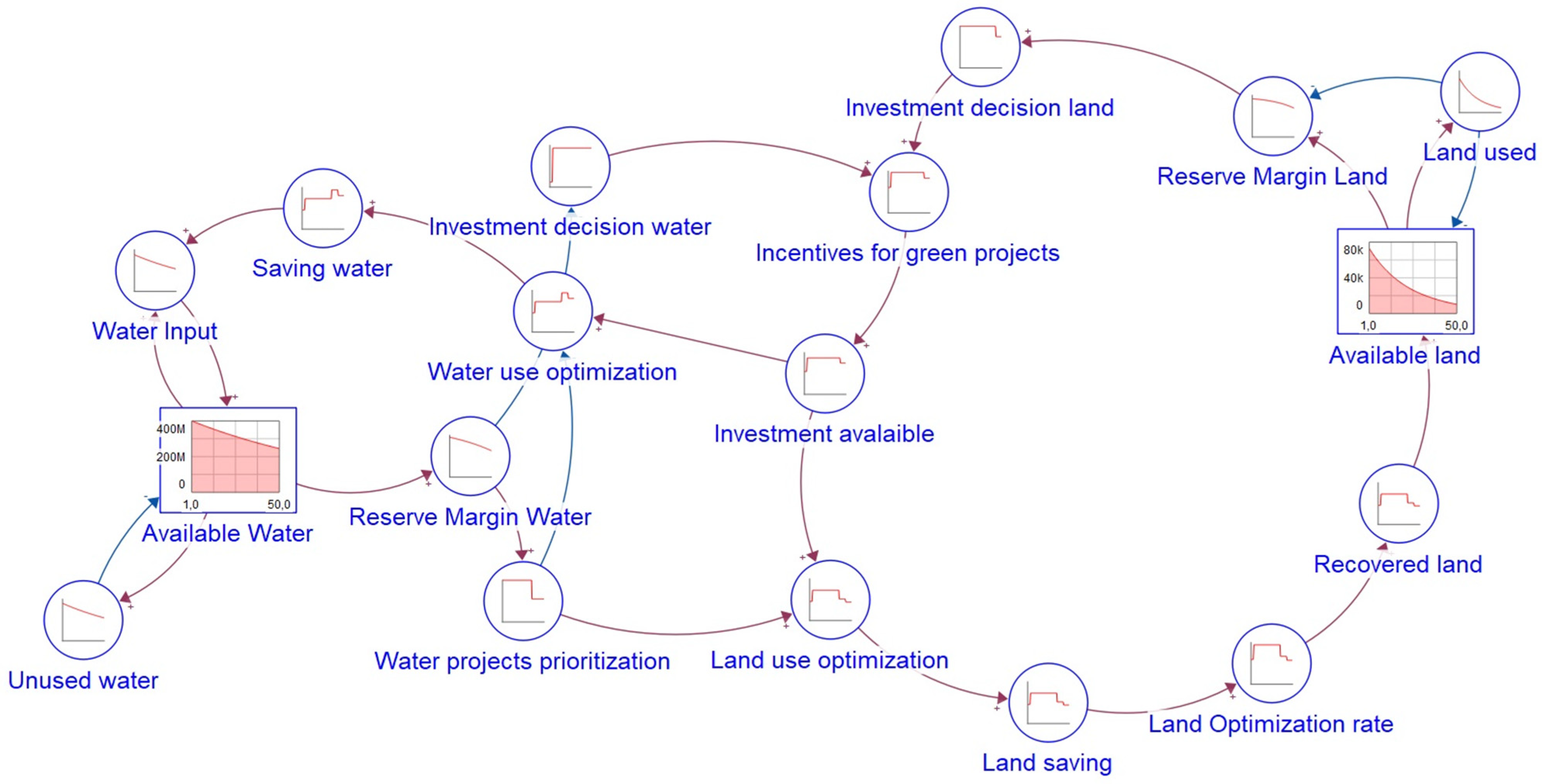
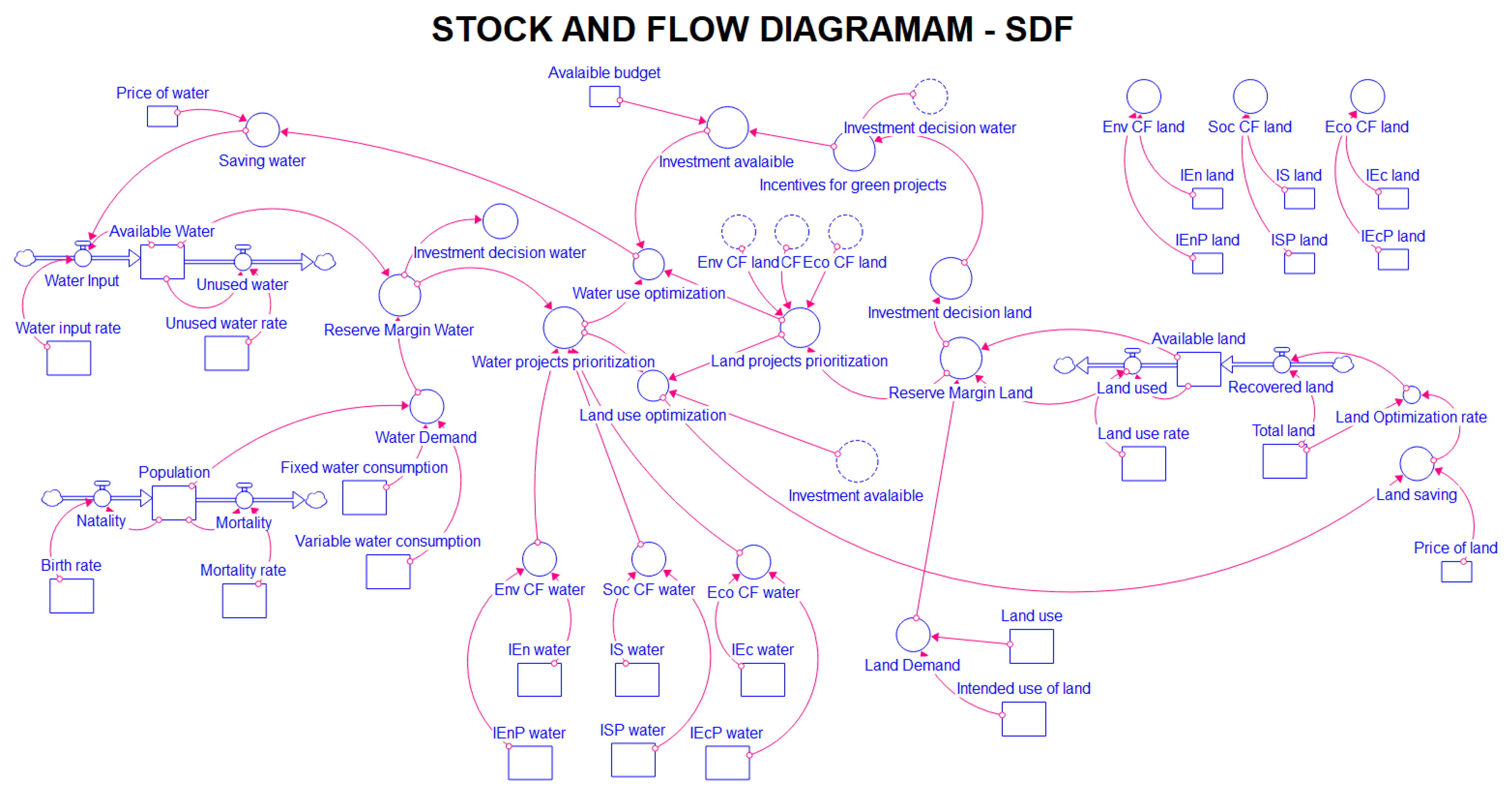
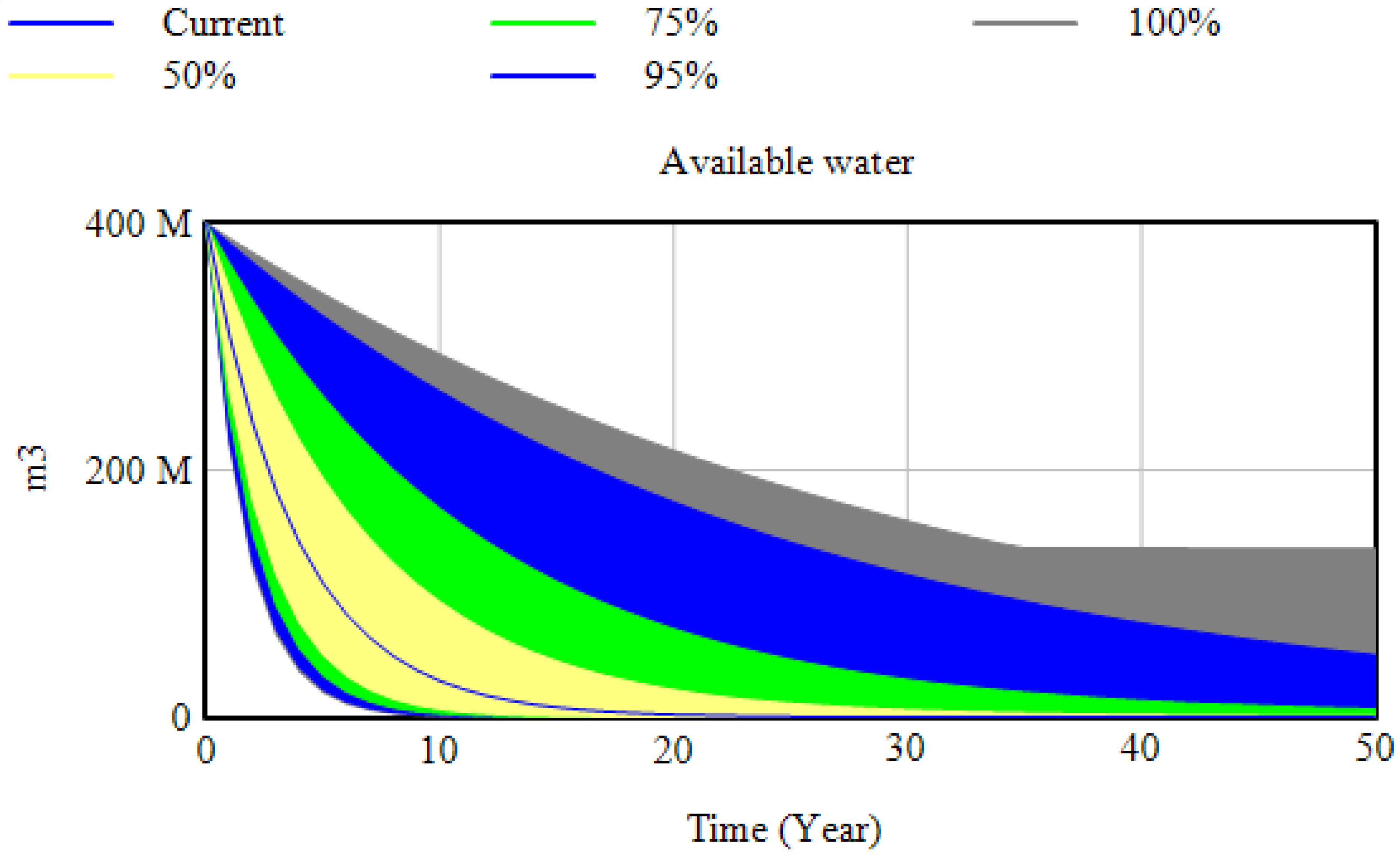
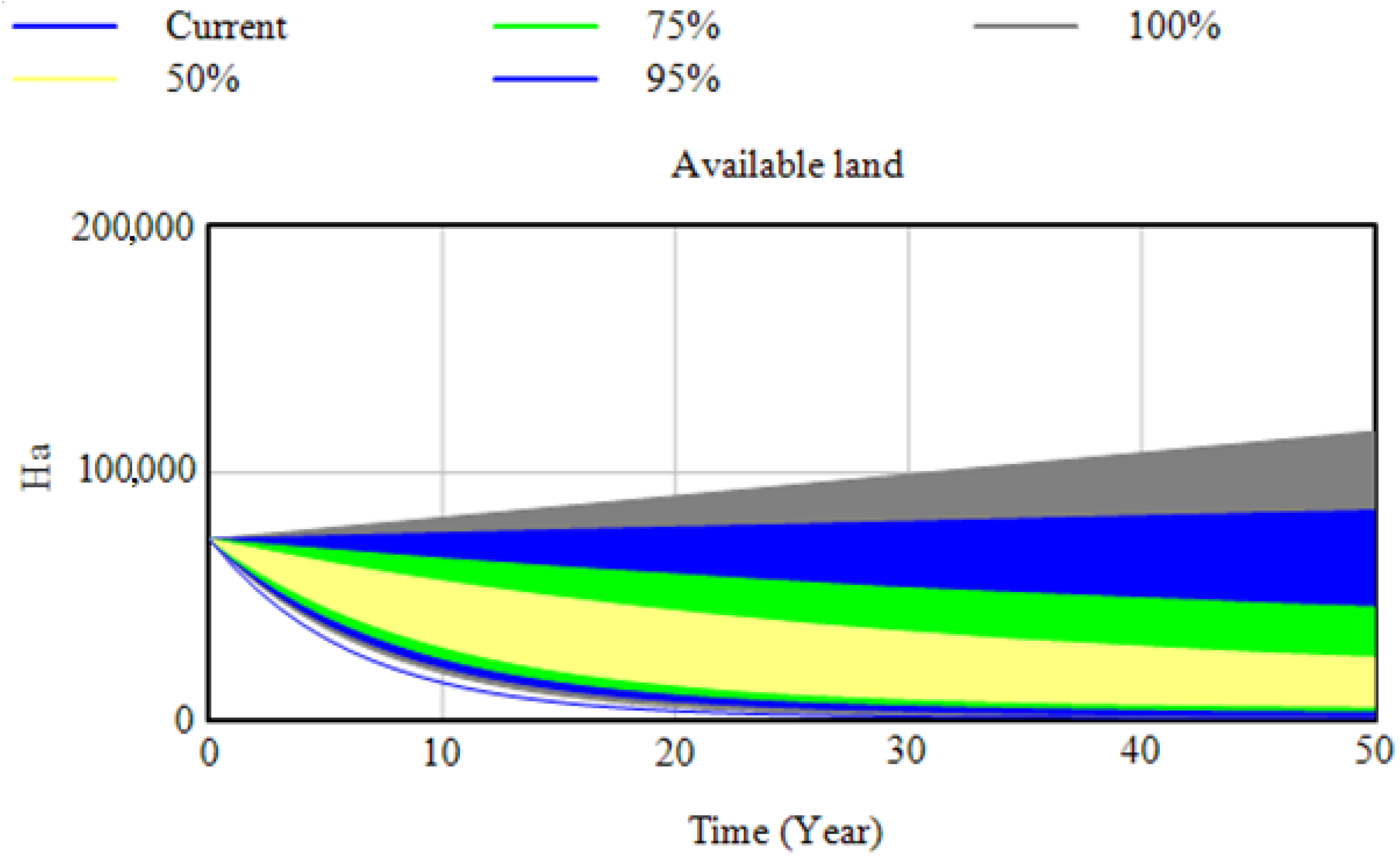

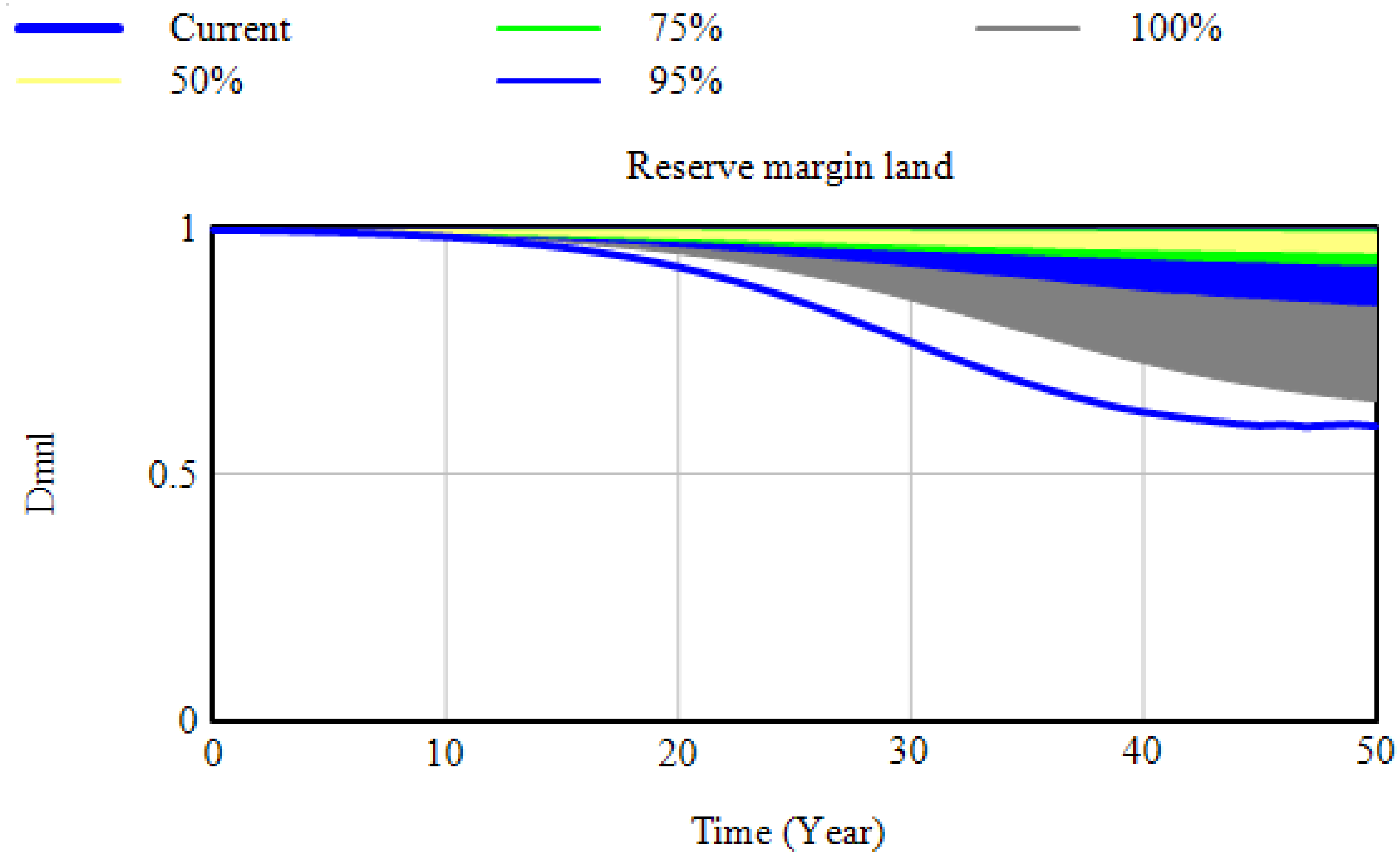
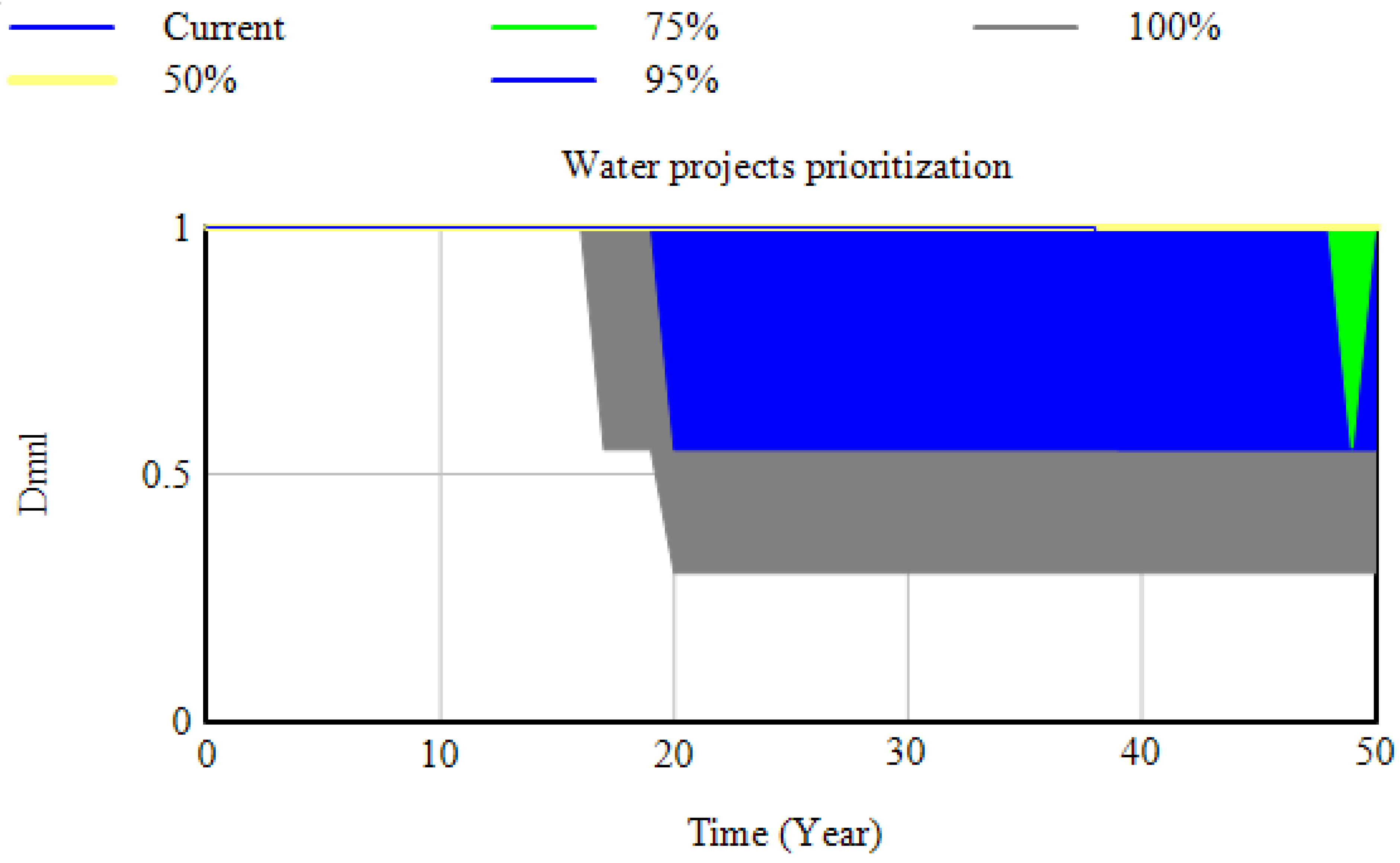
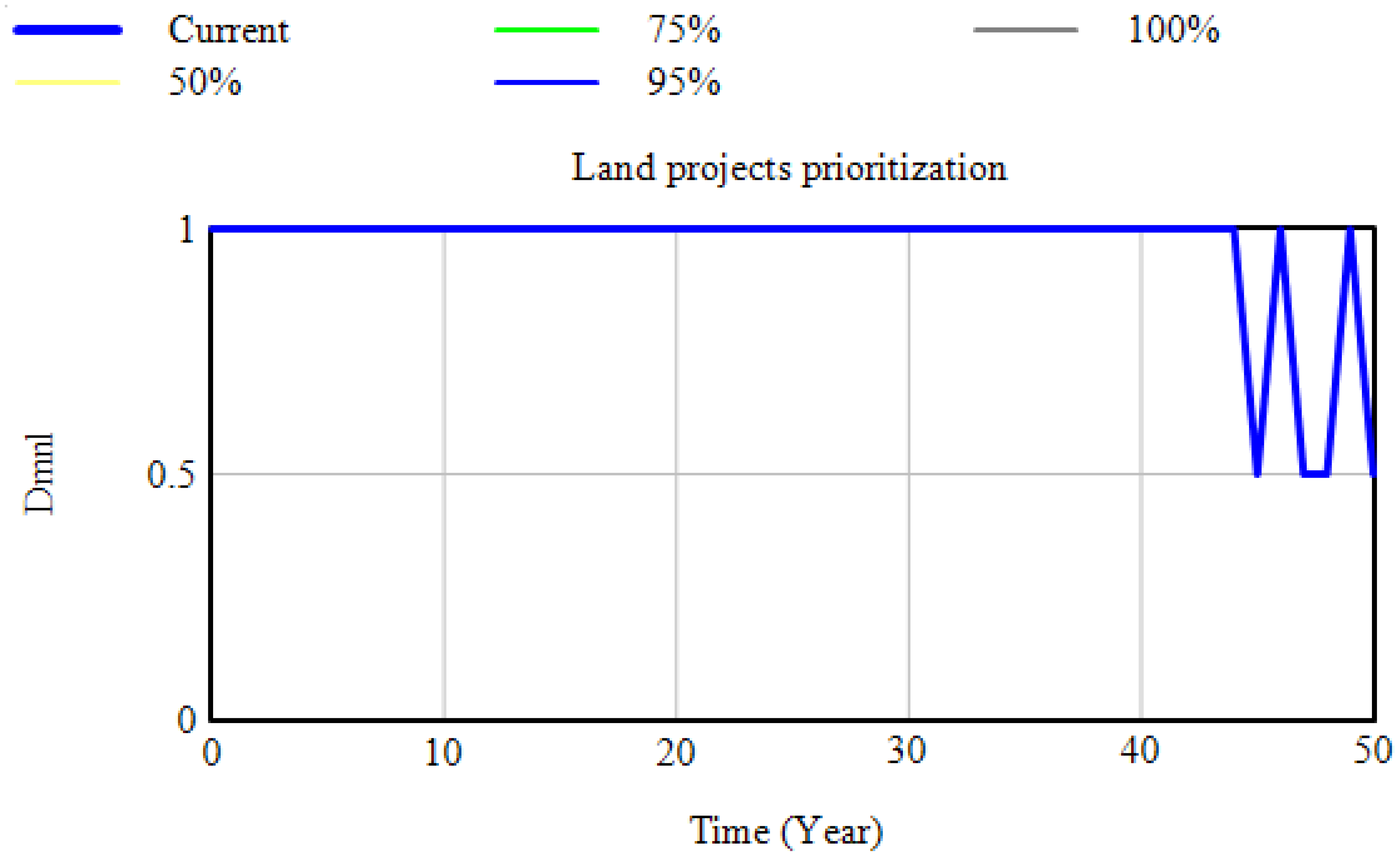
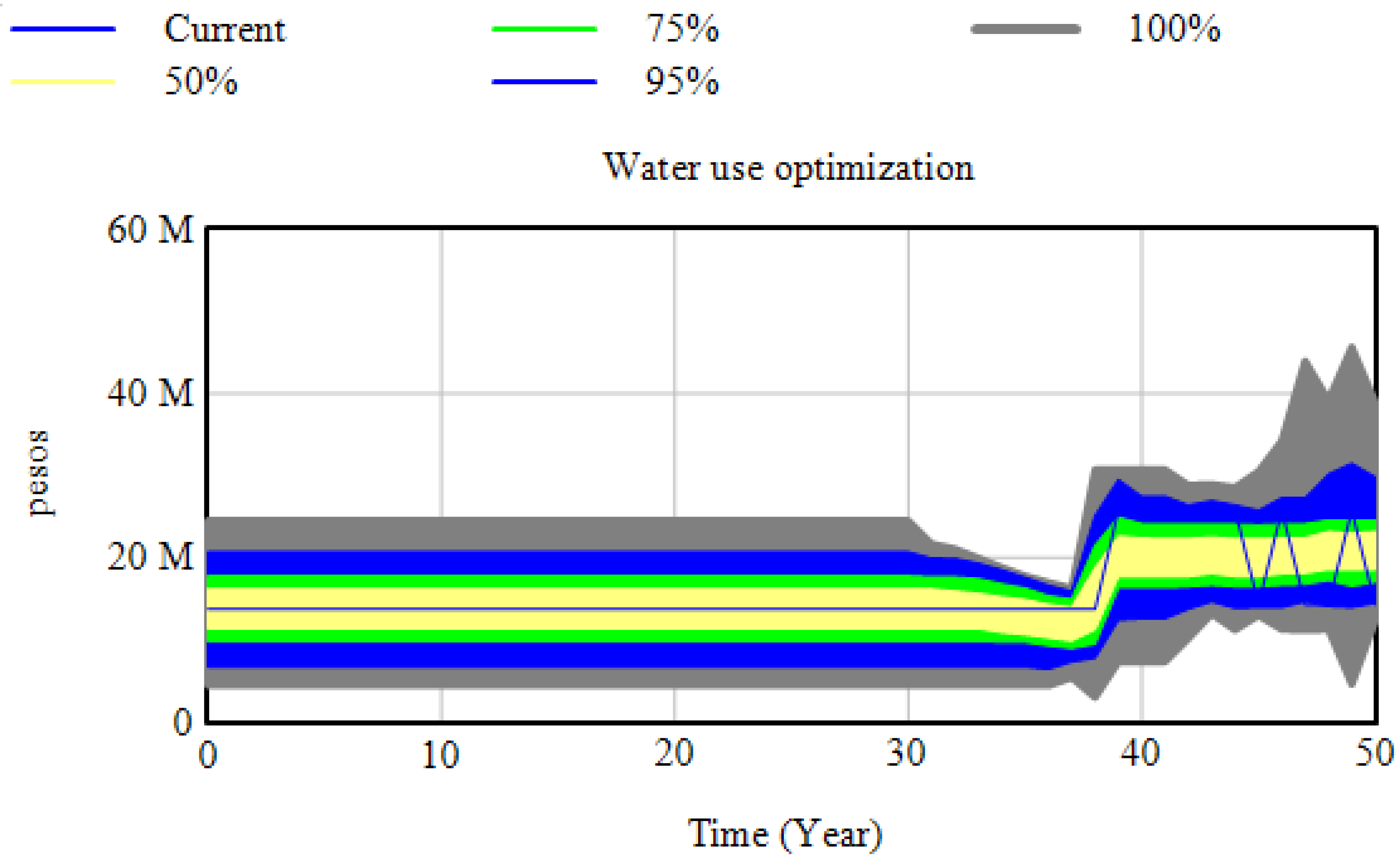
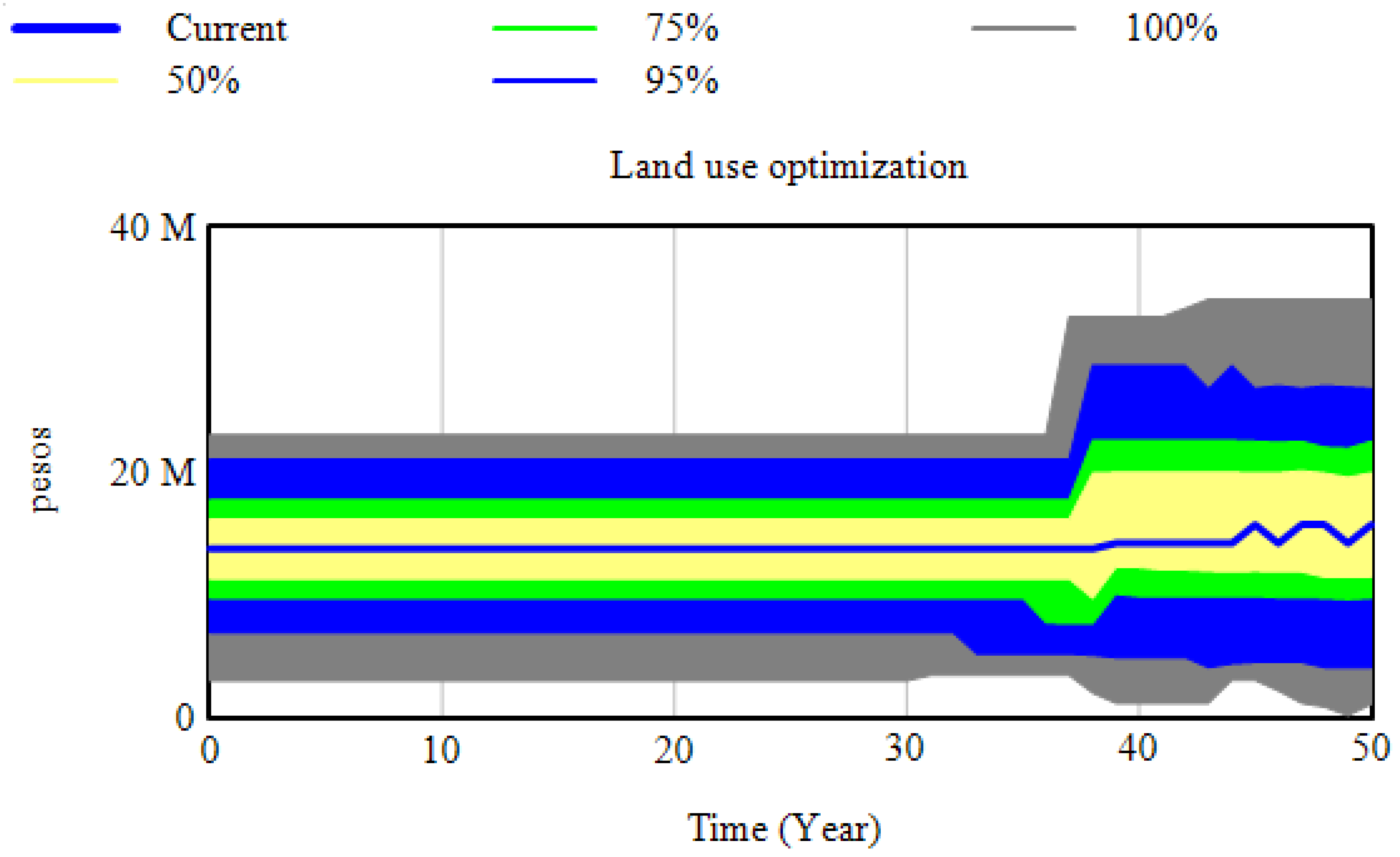
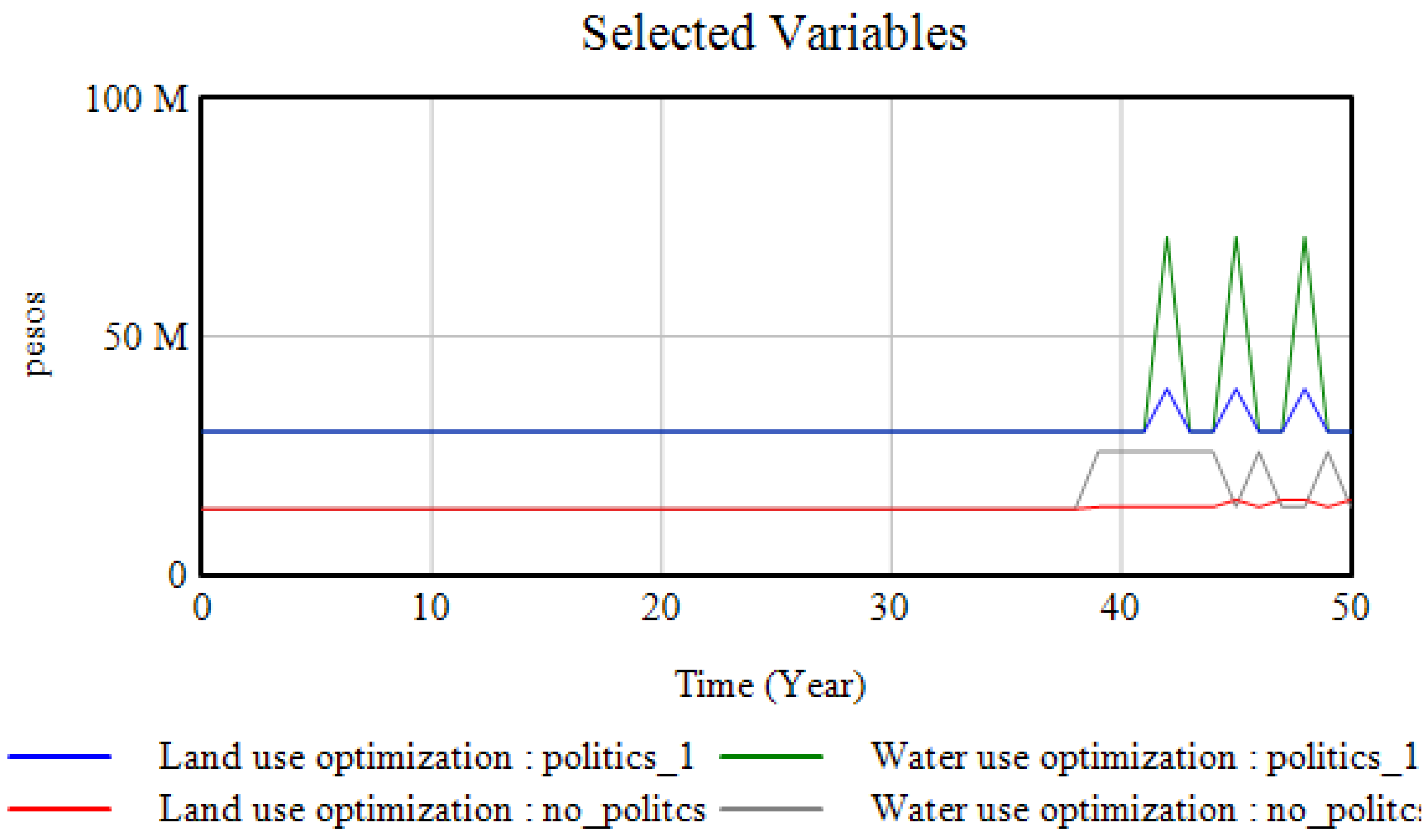


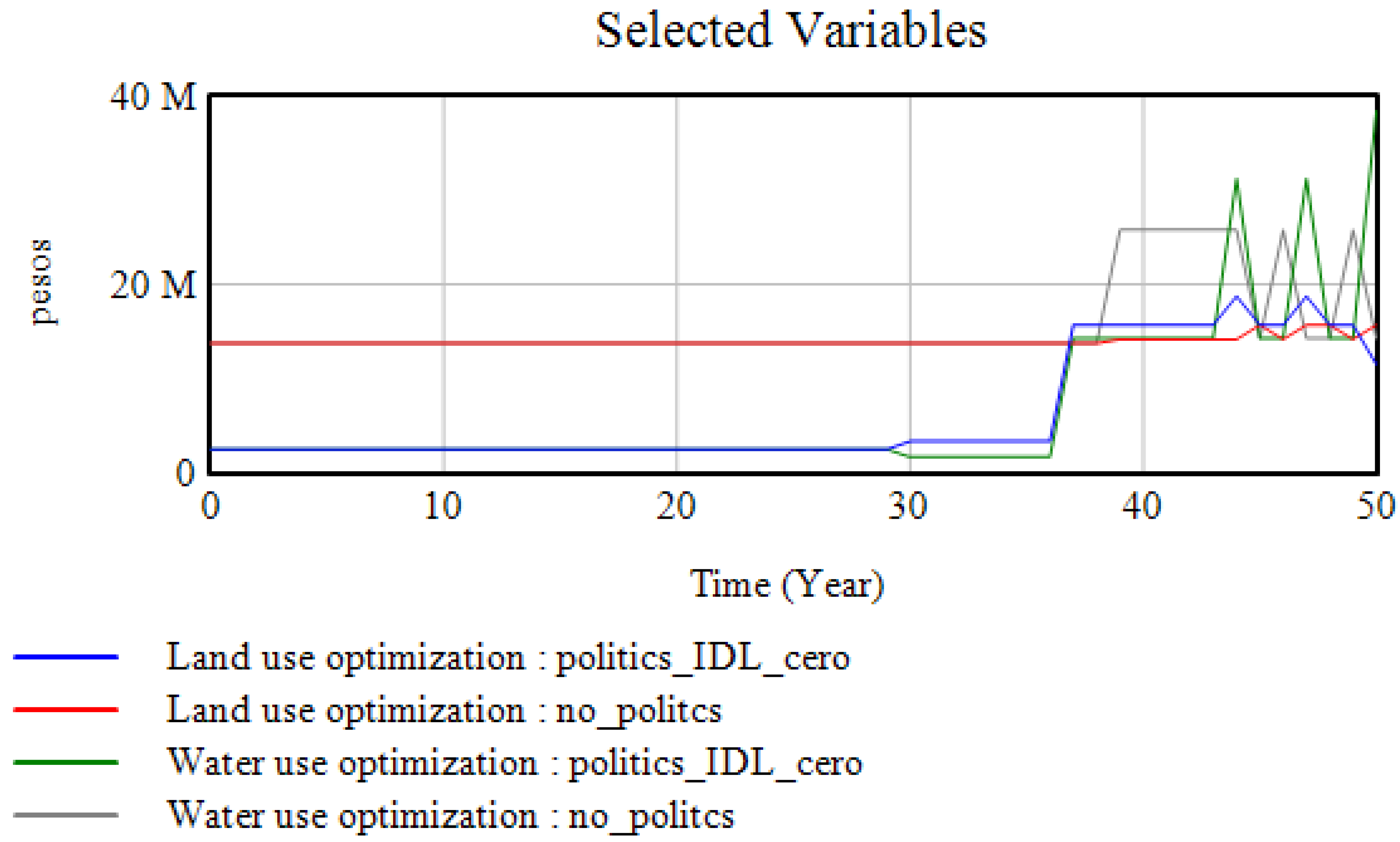
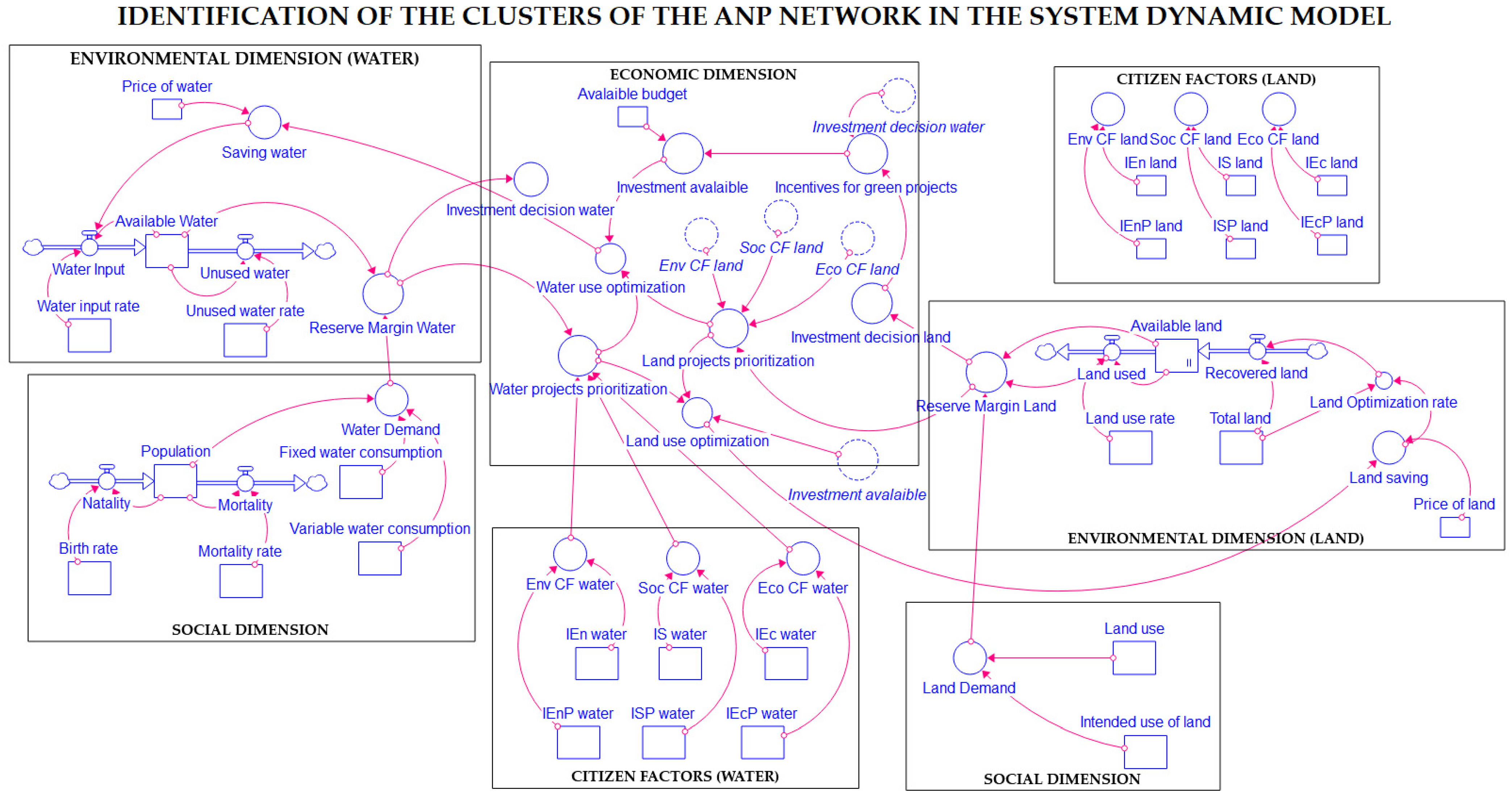
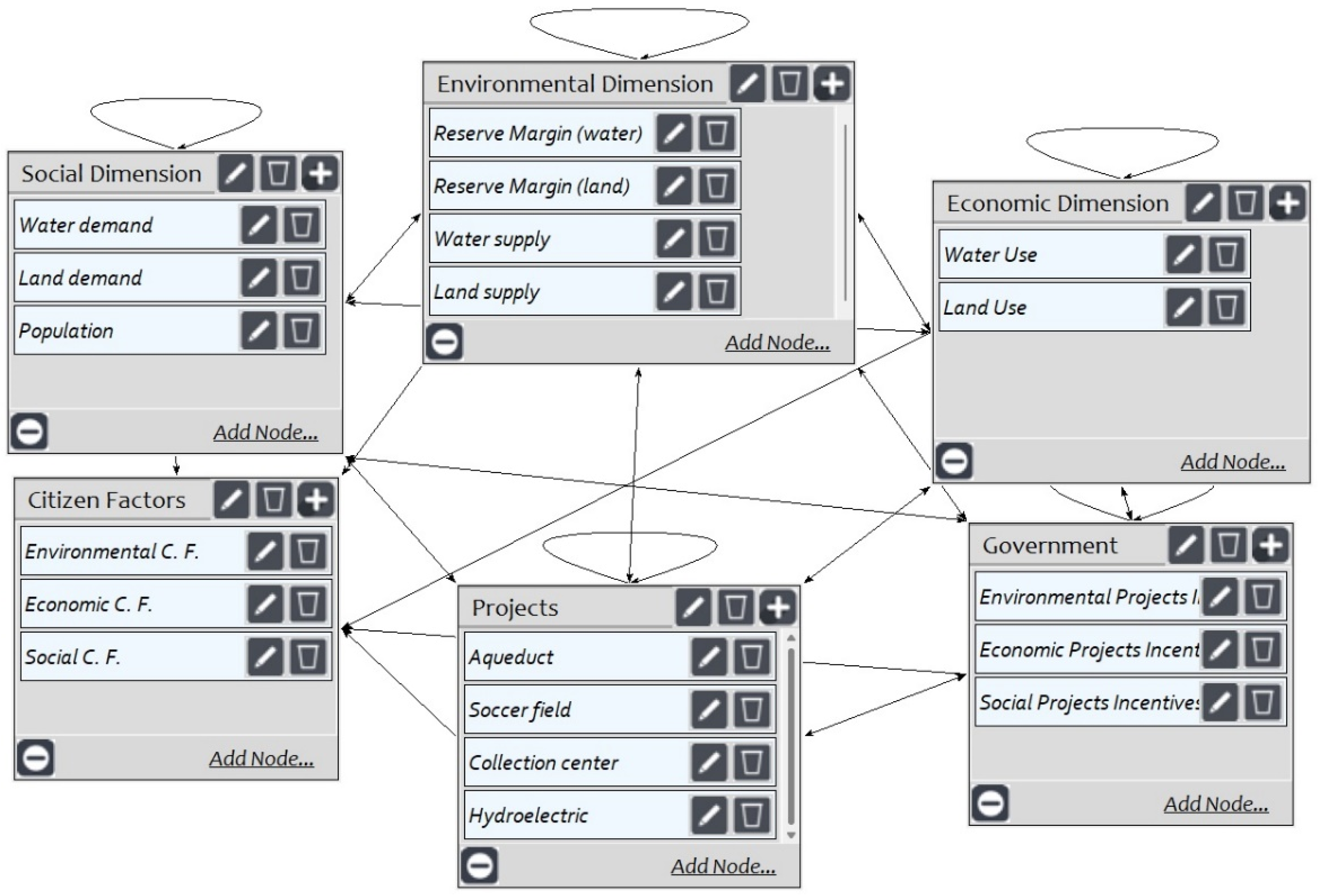
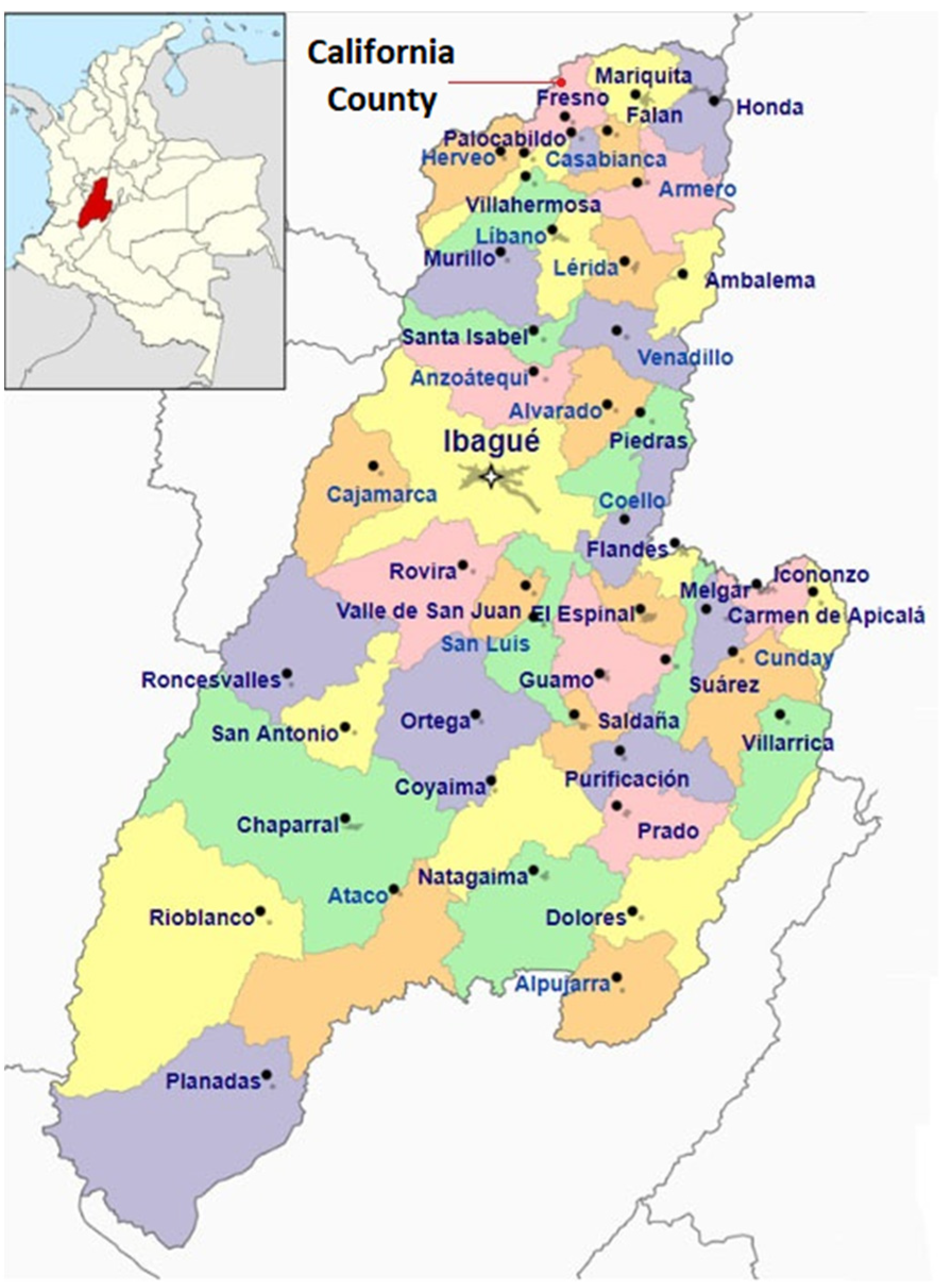
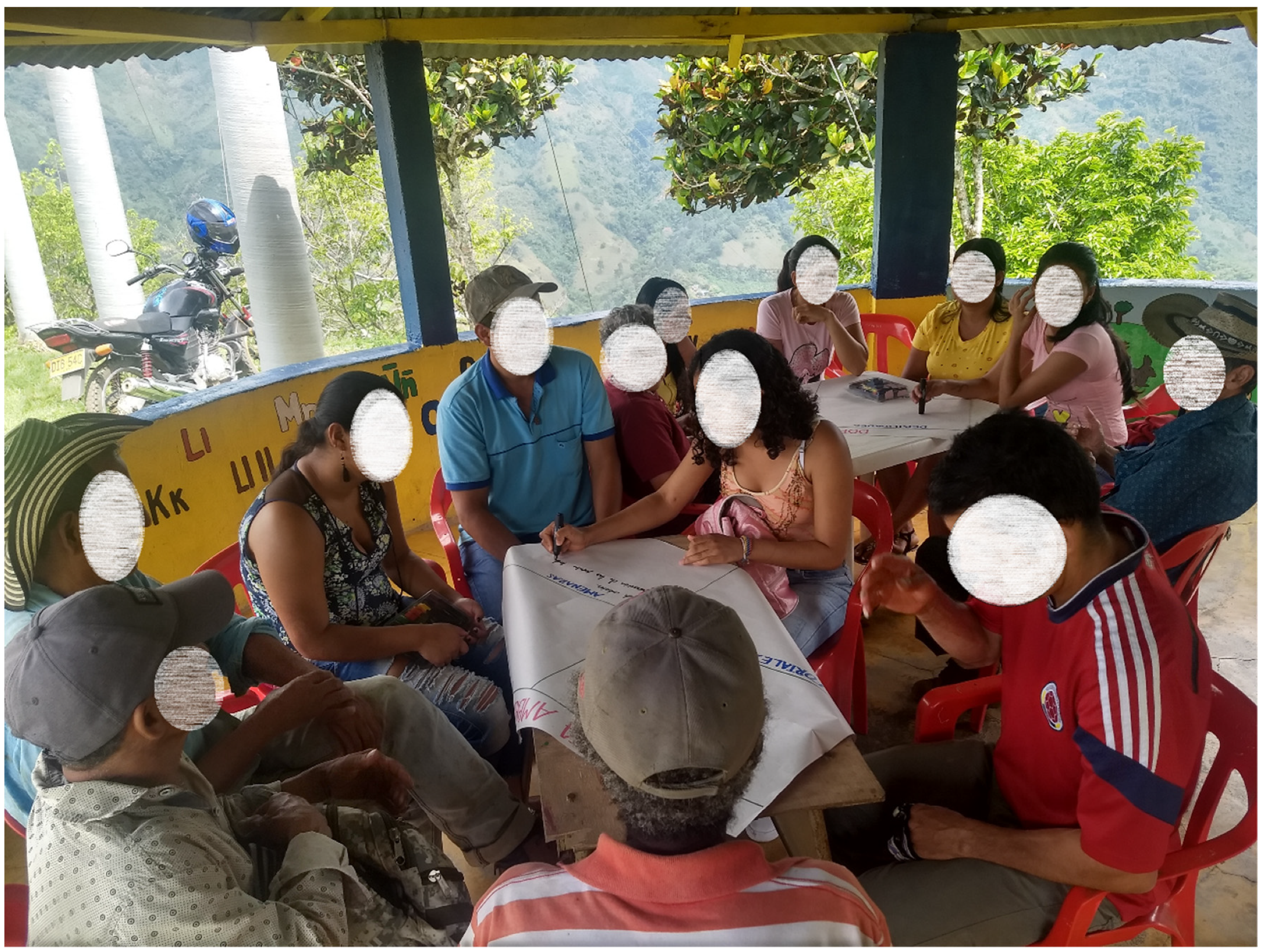
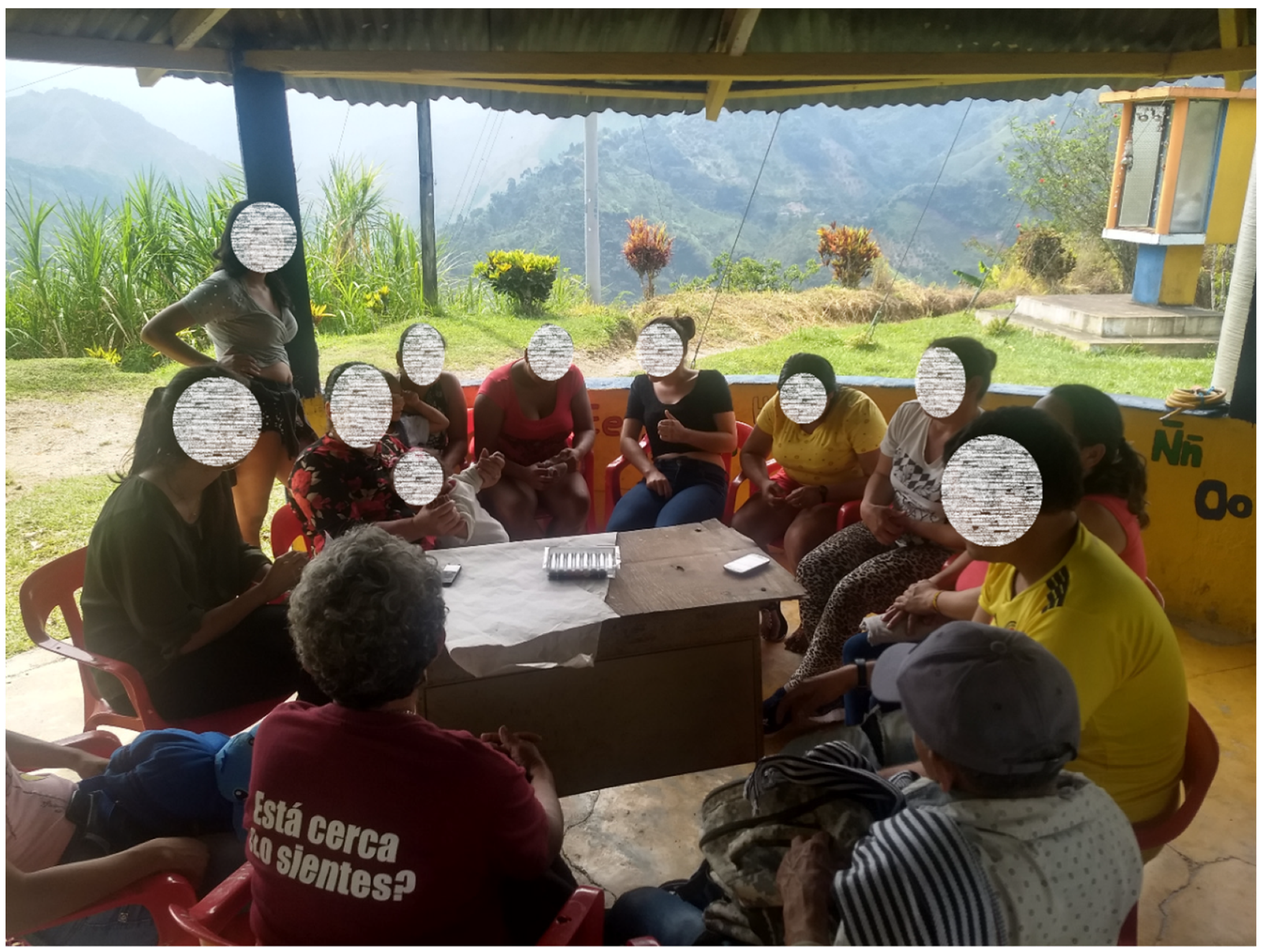
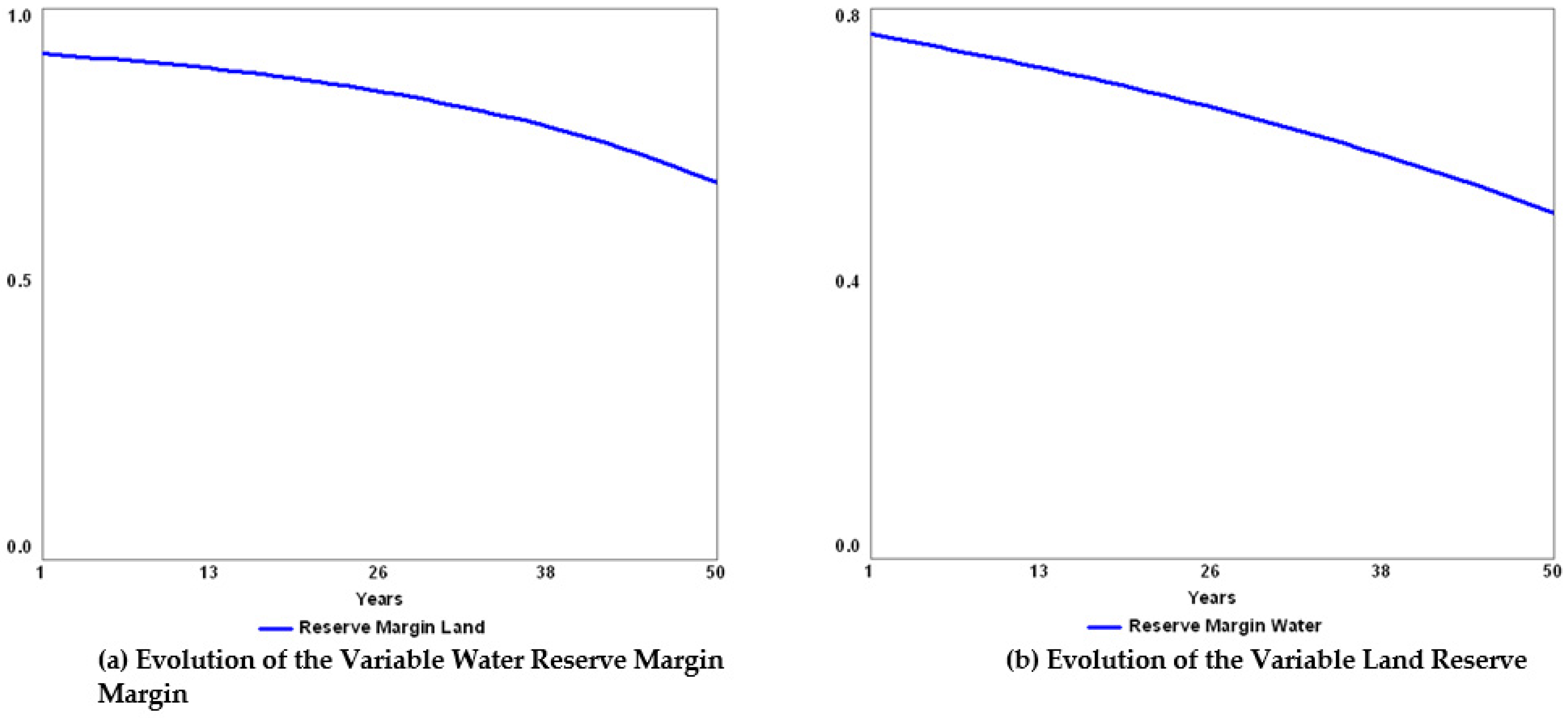
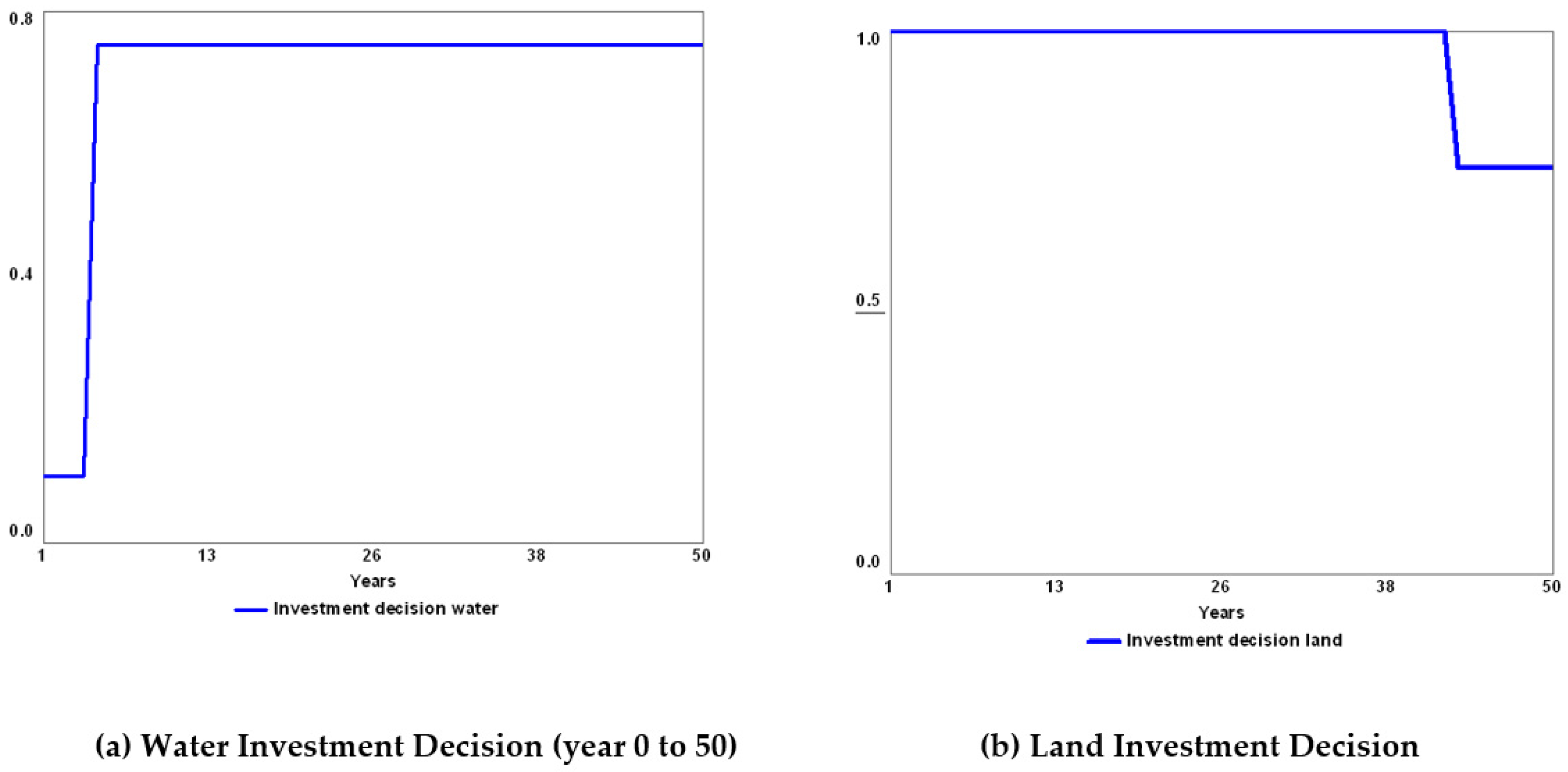
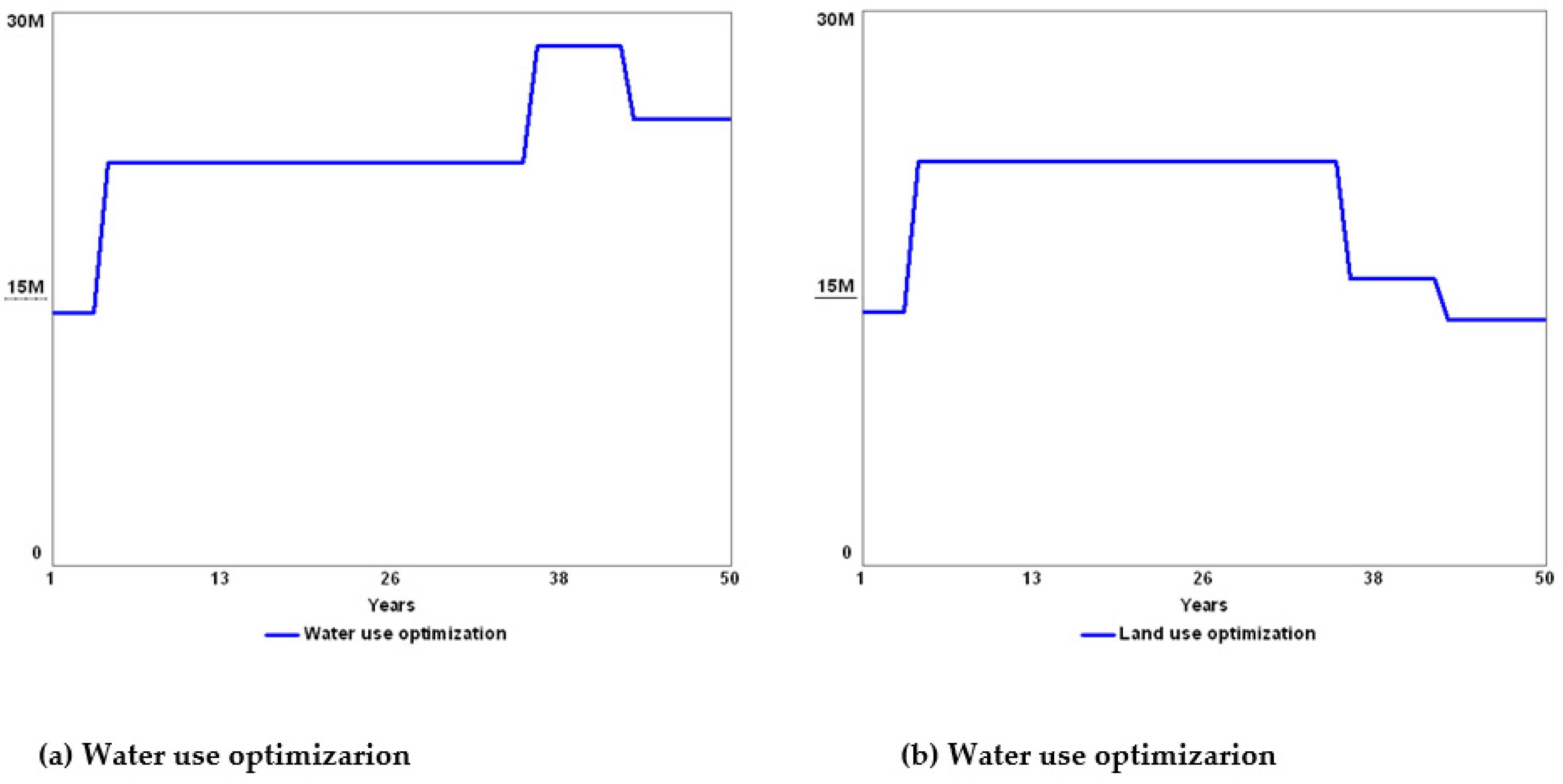
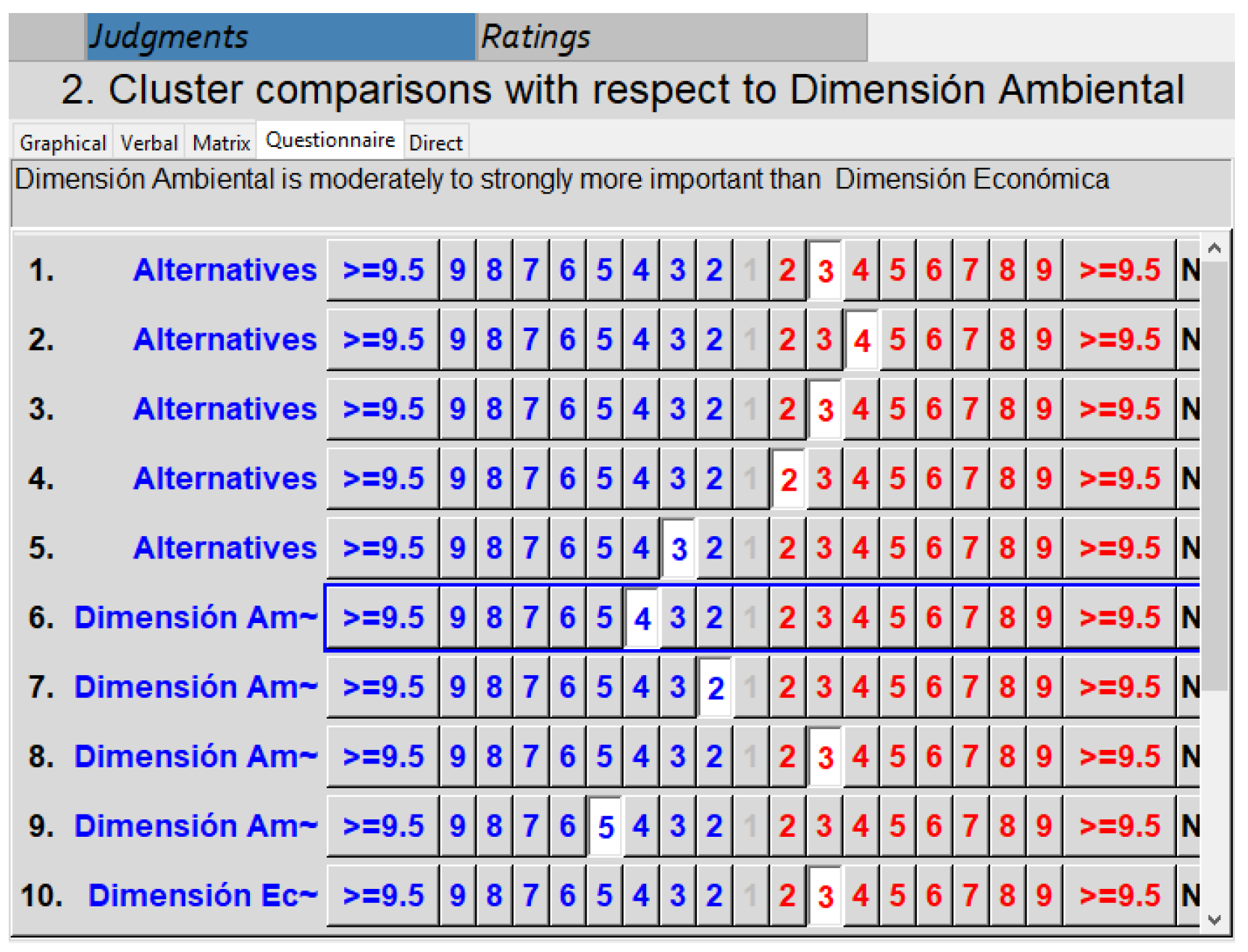
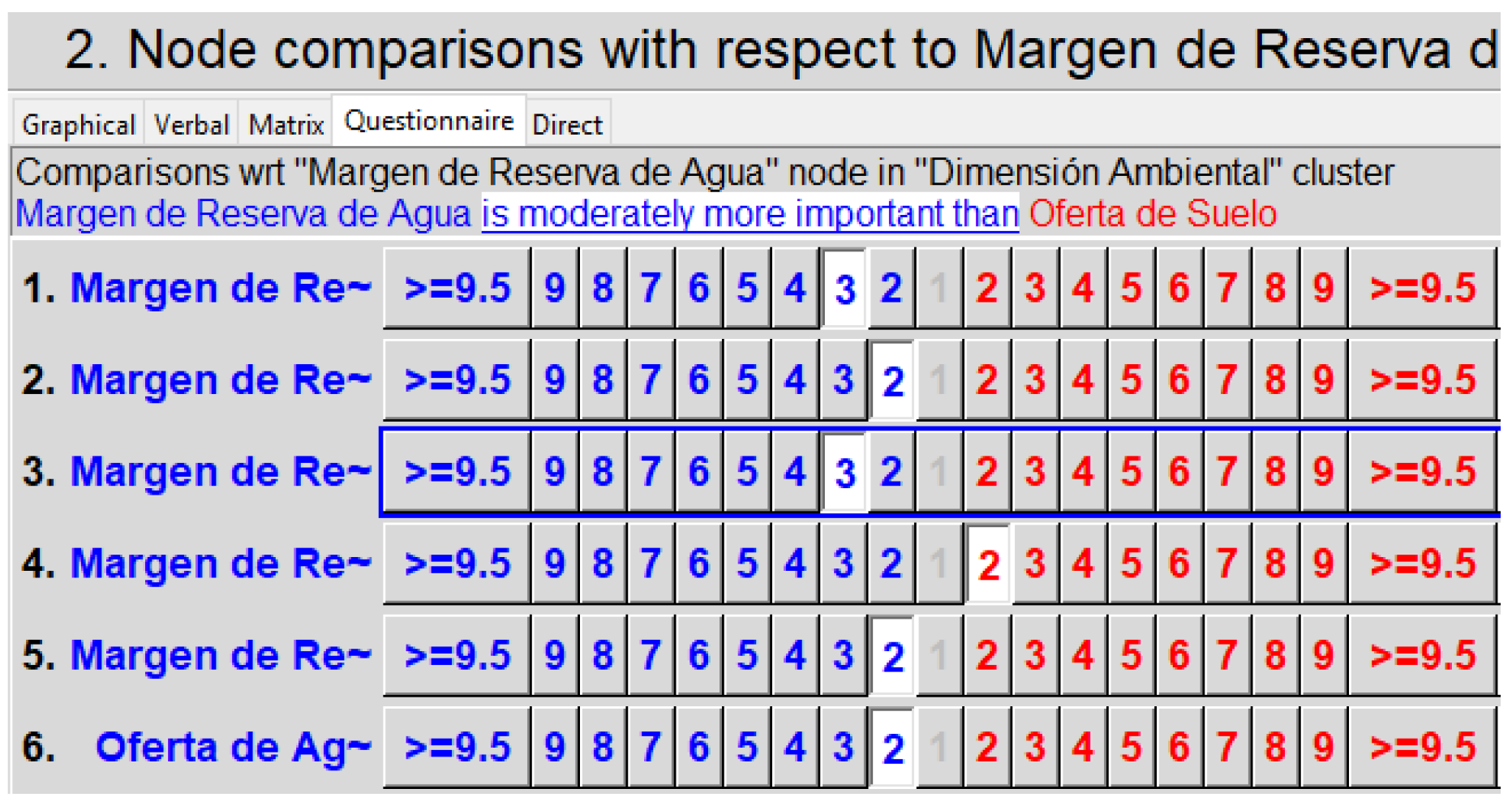
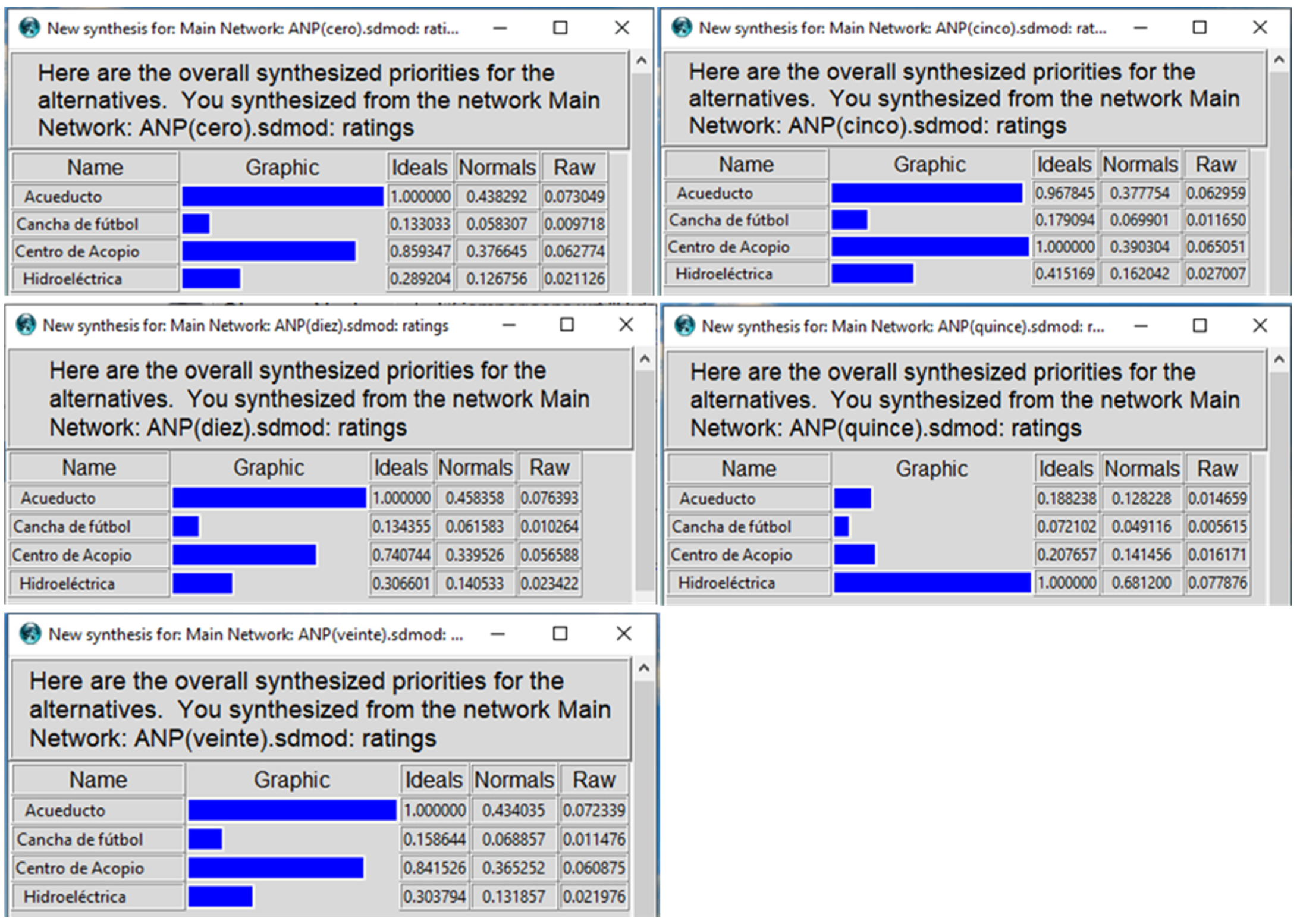
| Identified Finding | Dimension (ANP Network Cluster) | Used Tool |
|---|---|---|
| Difficulties in arriving to the county | Socioeconomic | Venn diagram |
| Small-scale agriculture (self-supply and external sale) | Socioeconomic | Venn diagram |
| Main products: cocoa, banana, avocado, and coffee | Socioeconomic | Venn diagram |
| Climate variety, many farming and fertile lands | Economic | SWOT |
| No agro-tourism-type projects are identified in the region | Economic and from the government | SWOT |
| Social connection | Social | SWOT |
| Abandonment by the state and local government | Social and from the government | Venn diagram |
| The population of the county, most of them left the county due to the violence in the nearby regions | Social | Semi-structured dialogue |
| Diversity of thought and approach to the problems and needs of the community | Social | Semi-structured dialogue |
| Impossibility of taking adequate advantage of natural resources and the existing share capital due to the lack of institutional support in the development of high-impact projects and lack of training for its inhabitants | Socioeconomic and from the government | Semi-structured dialogue |
| Soil affectation (in exchange for better productivity) using pesticides and agrochemicals in crops | Socioeconomic | Semi-structured dialogue |
| The community of California recognizes that technification in their crops can mean greater competitive capacity in the market, and a better position of their products with more profitable prizes | Socioeconomic | Semi-structured dialogue |
| The natural resource of water is widely accessible to the inhabitants, so it can be consumed directly from the springs and gorges of the zone | Environmental | Semi-structured dialogue |
| The community recognizes the problems that underlie the consumption of non-potable water in relation to the generation of diseases. | Social environmental | Venn diagram |
| Industrialization processes or widespread growth of the main crops are not identified in the county, small-scale agricultural production being the main economic source, likewise the underemployment in the nearby counties | Economic | Venn diagram |
| Project management or resources for productive projects in the county are not identified, which makes the improvement in the physical, economic, natural, and cultural conditions of the community difficult | Government | Semi-structured dialogue |
| Parameter | Description | Value | Units | Source |
|---|---|---|---|---|
| Water Input Rate | Amount of water provided by the different tributaries in the area per year | 22 | % | [30,31] |
| Unused Water Rate | Amount of water not consumed or used per year | 45 | % | [30,31] |
| Variable Consumption of Water | Amount of water consumed above the annual average | 60 | Cubic meters | [30,31] |
| Fixed Consumption of Water | Amount of water consumed per year | 130 | Cubic meters | [30,31] |
| Population | Number of inhabitants | 200 | People | [30,31] |
| Price of Water | Value paid per m3 of water | 6000 | Pesos | [30,31] |
| Available Budget | Amount of money available for investment | 50 | Millions of pesos | Model assumption |
| Price of Land | Average value paid per hectare of land | 150 | Thousands of pesos | [30,31] |
| Land Use | Amount of land consumed per year | 9000 | Hectares | [30,31] |
| Intended Use of Land | Proportion of land (of the total) planned to be used for the following years | 30 | % | [30,31] |
| Land Use Rate | Proportion of land (of the total) used each year | 15 | % | [30,31] |
| Total Land | Total hectares of land (used and unused) | 515 | Thousands of hectares | [30,31] |
| FCSwater | Social citizen factor (water) | 20% | Dimensionless | Participatory workshop |
| FCAwater | Environmental citizen factor (Water) | 25% | Dimensionless | Participatory workshop |
| FCEwater | Economic citizen factor (water) | 55% | Dimensionless | Participatory workshop |
| FCSland | Social citizen factor (land) | 10% | Dimensionless | Participatory workshop |
| FCAland | Environmental citizen factor (land) | 30% | Dimensionless | Participatory workshop |
| FCEland | Economic citizen factor (land) | 60% | Dimensionless | Participatory workshop |
| Value | Definition | Comment |
|---|---|---|
| 1 | Equal importance | Criterion A is just as important as criterion B |
| 3 | Moderate importance | Experience and judgment slightly favor criterion A over criterion B. |
| 5 | Big importance | Experience and judgment strongly favor criterion A over criterion B |
| 7 | Very big importance | Criterion A is much more important than criterion B. |
| 9 | Extreme importance | The greater importance of criterion A over B is beyond doubt |
| 2, 4, 6, 8 | Intermediate values between the previous ones, when it is necessary to qualify | |
| Project | Year 0 | Weight 40% | Year Five | Weight 30% | Year Ten | Weight 15% | Year Fifteen | Weight 10% | Year Twenty | Weight 5% | Final Result |
|---|---|---|---|---|---|---|---|---|---|---|---|
| Aqueduct | 0.438 | 0.175 | 0.377 | 0.113 | 0.458 | 0.068 | 0.128 | 0.012 | 0.434 | 0.021 | 0.391 |
| Soccer Field | 0.058 | 0.023 | 0.069 | 0.020 | 0.061 | 0.009 | 0.049 | 0.004 | 0.0688 | 0.003 | 0.061 |
| Collection Center | 0.376 | 0.150 | 0.390 | 0.117 | 0.339 | 0.050 | 0.141 | 0.014 | 0.3652 | 0.018 | 0.351 |
| Hydroelectric | 0.126 | 0.050 | 0.162 | 0.048 | 0.140 | 0.021 | 0.681 | 0.068 | 0.1318 | 0.006 | 0.195 |
Publisher’s Note: MDPI stays neutral with regard to jurisdictional claims in published maps and institutional affiliations. |
© 2022 by the authors. Licensee MDPI, Basel, Switzerland. This article is an open access article distributed under the terms and conditions of the Creative Commons Attribution (CC BY) license (https://creativecommons.org/licenses/by/4.0/).
Share and Cite
Castrillon-Gomez, J.A.; Olivar-Tost, G.; Valencia-Calvo, J. Systems Dynamics and the Analytical Network Process for the Evaluation and Prioritization of Green Projects: Proposal That Involves Participative Integration. Sustainability 2022, 14, 11519. https://doi.org/10.3390/su141811519
Castrillon-Gomez JA, Olivar-Tost G, Valencia-Calvo J. Systems Dynamics and the Analytical Network Process for the Evaluation and Prioritization of Green Projects: Proposal That Involves Participative Integration. Sustainability. 2022; 14(18):11519. https://doi.org/10.3390/su141811519
Chicago/Turabian StyleCastrillon-Gomez, Julian Andres, Gerard Olivar-Tost, and Johnny Valencia-Calvo. 2022. "Systems Dynamics and the Analytical Network Process for the Evaluation and Prioritization of Green Projects: Proposal That Involves Participative Integration" Sustainability 14, no. 18: 11519. https://doi.org/10.3390/su141811519
APA StyleCastrillon-Gomez, J. A., Olivar-Tost, G., & Valencia-Calvo, J. (2022). Systems Dynamics and the Analytical Network Process for the Evaluation and Prioritization of Green Projects: Proposal That Involves Participative Integration. Sustainability, 14(18), 11519. https://doi.org/10.3390/su141811519










